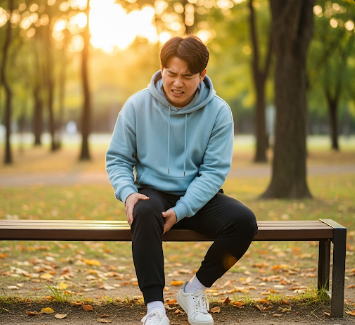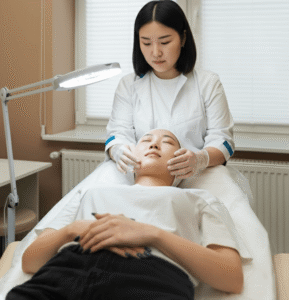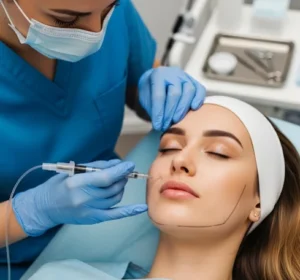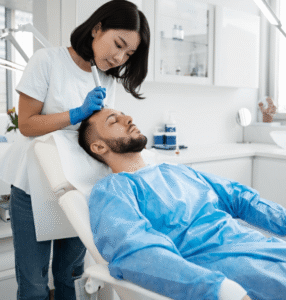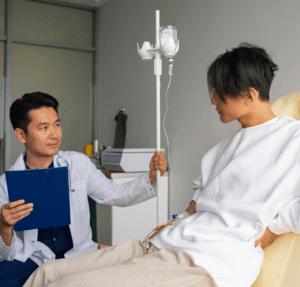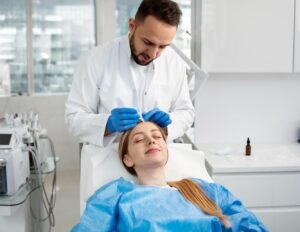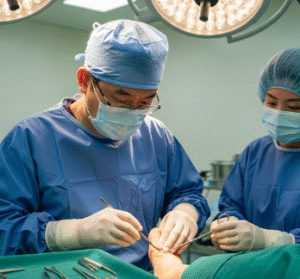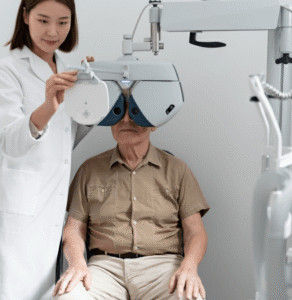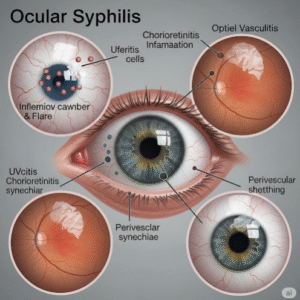Overview
Knee pain is one of the most common musculoskeletal complaints, affecting people of all ages. It refers to discomfort or pain in or around the knee joint, which may be acute or chronic, mild or severe. Knee pain can result from injuries, degenerative conditions, inflammatory diseases, or biomechanical issues.
In Korea, orthopedic and rehabilitation clinics provide comprehensive evaluation and treatment for knee pain. Advanced diagnostic imaging, minimally invasive procedures, physiotherapy, and surgical options allow for precise treatment and long-term management, helping patients regain mobility and quality of life.
Key Facts
- ➔ Knee pain can affect one or both knees and may involve ligaments, tendons, cartilage, or bones.
- ➔ Common causes include osteoarthritis, ligament injuries, meniscus tears, bursitis, and patellar disorders.
- ➔ Pain may be sharp, dull, aching, or throbbing, often worsening with activity.
- ➔ Swelling, stiffness, instability, or popping sounds can accompany knee pain.
- ➔ Early diagnosis and targeted treatment can prevent chronic disability and improve function.
What is Knee Pain?
Knee pain refers to discomfort in or around the knee joint, which is a complex structure composed of bones, cartilage, ligaments, tendons, and synovial fluid.
- ➔ Acute knee pain: Often results from trauma or sudden injury.
- ➔ Chronic knee pain: Develops gradually, typically due to degenerative changes or inflammatory conditions.
- ➔ Referred pain: Sometimes originates from the hip, lower back, or other structures.
- ➔ Clinical significance: Persistent knee pain can limit mobility, affect daily activities, and contribute to long-term joint degeneration.
What Symptoms Are Related To
Knee pain may present with a variety of symptoms depending on its cause:
- ➔ Swelling or edema around the joint
- ➔ Stiffness, especially in the morning or after prolonged activity
- ➔ Warmth or redness over the joint (suggesting inflammation)
- ➔ Clicking, popping, or grinding sounds
- ➔ Instability or “giving way” of the knee
- ➔ Difficulty bending or straightening the knee
- ➔ Pain that worsens with activity or prolonged standing
Recognizing these symptoms helps differentiate traumatic injuries, degenerative changes, or inflammatory causes.
What Causes / Possible Causes
Knee pain can arise from a wide range of conditions:
- ➔ Osteoarthritis: Degeneration of cartilage leading to pain, stiffness, and swelling.
- ➔ Ligament injuries: ACL, PCL, MCL, or LCL tears often result from sports injuries.
- ➔ Meniscus tears: Damage to the cartilage that cushions the knee joint.
- ➔ Tendinitis or bursitis: Inflammation of tendons or fluid-filled sacs around the knee.
- ➔ Patellofemoral pain syndrome: Misalignment or overuse causing anterior knee pain.
- ➔ Rheumatoid arthritis or other inflammatory conditions: Chronic inflammation damaging joint structures.
- ➔ Trauma or fractures: Accidents, falls, or direct blows to the knee.
- ➔ Overuse or biomechanical issues: Repetitive stress, obesity, or improper gait contributing to chronic pain.
Identifying the cause is essential for effective treatment and long-term joint health.
When Should I See My Doctor
Consult a healthcare provider if you experience:
- ➔ Severe, persistent, or worsening knee pain
- ➔ Swelling, redness, or warmth of the joint
- ➔ Instability or inability to bear weight
- ➔ Locking or limited range of motion
- ➔ Pain following injury or trauma
- ➔ Signs of infection, such as fever with joint pain
- ➔ Chronic knee pain affecting daily activities
Early evaluation prevents progression of joint damage and allows timely interventions to restore function.
Care and Treatment
Treatment of knee pain depends on the underlying cause:
- ➔ Conservative care: Rest, ice, compression, elevation (RICE), and activity modification
- ➔ Physical therapy: Strengthening muscles around the knee, improving flexibility, and correcting gait issues
- ➔ Medications: Pain relievers, anti-inflammatory drugs, or corticosteroid injections for inflammation
- ➔ Supportive devices: Knee braces or orthotics to reduce stress on the joint
- ➔ Minimally invasive procedures: Arthroscopy for meniscus repair or cartilage smoothing
- ➔ Surgical interventions: Knee replacement or ligament reconstruction for severe or irreparable damage
- ➔ Lifestyle modifications: Weight management, low-impact exercise, and ergonomic adjustments to prevent recurrence
Regular monitoring and adherence to treatment can reduce pain, improve mobility, and prevent long-term joint degeneration.
Treatment Options in Korea
Korean orthopedic and rehabilitation centers offer advanced care for knee pain:
- ➔ Diagnostic imaging: X-ray, MRI, CT scan, and ultrasound to identify structural damage
- ➔ Physical rehabilitation: Supervised physiotherapy programs for pain relief and functional recovery
- ➔ Minimally invasive procedures: Arthroscopic surgery for meniscus tears, ligament repair, or cartilage restoration
- ➔ Joint injections: Corticosteroids, hyaluronic acid, or platelet-rich plasma (PRP) therapy
- ➔ Surgical interventions: Partial or total knee replacement for advanced osteoarthritis or severe joint damage
- ➔ Multidisciplinary care: Collaboration between orthopedic surgeons, physiotherapists, and pain specialists for personalized treatment
- ➔ Leading hospitals: Seoul National University Hospital, Asan Medical Center, and Samsung Medical Center provide state-of-the-art diagnostics and treatment plans for knee pain.
With comprehensive care, patients can relieve pain, regain mobility, and improve overall quality of life.
In Summary: Knee pain is a common yet complex condition that can result from injury, degeneration, inflammation, or biomechanical issues. Early recognition, accurate diagnosis, and advanced treatment in Korea can relieve pain, restore function, and prevent long-term joint complications.
- ➔ Key Takeaway: Persistent or severe knee pain requires medical evaluation to prevent chronic disability.
- ➔ Action Point: Consult an orthopedic specialist or rehabilitation clinic for thorough assessment and personalized care.

